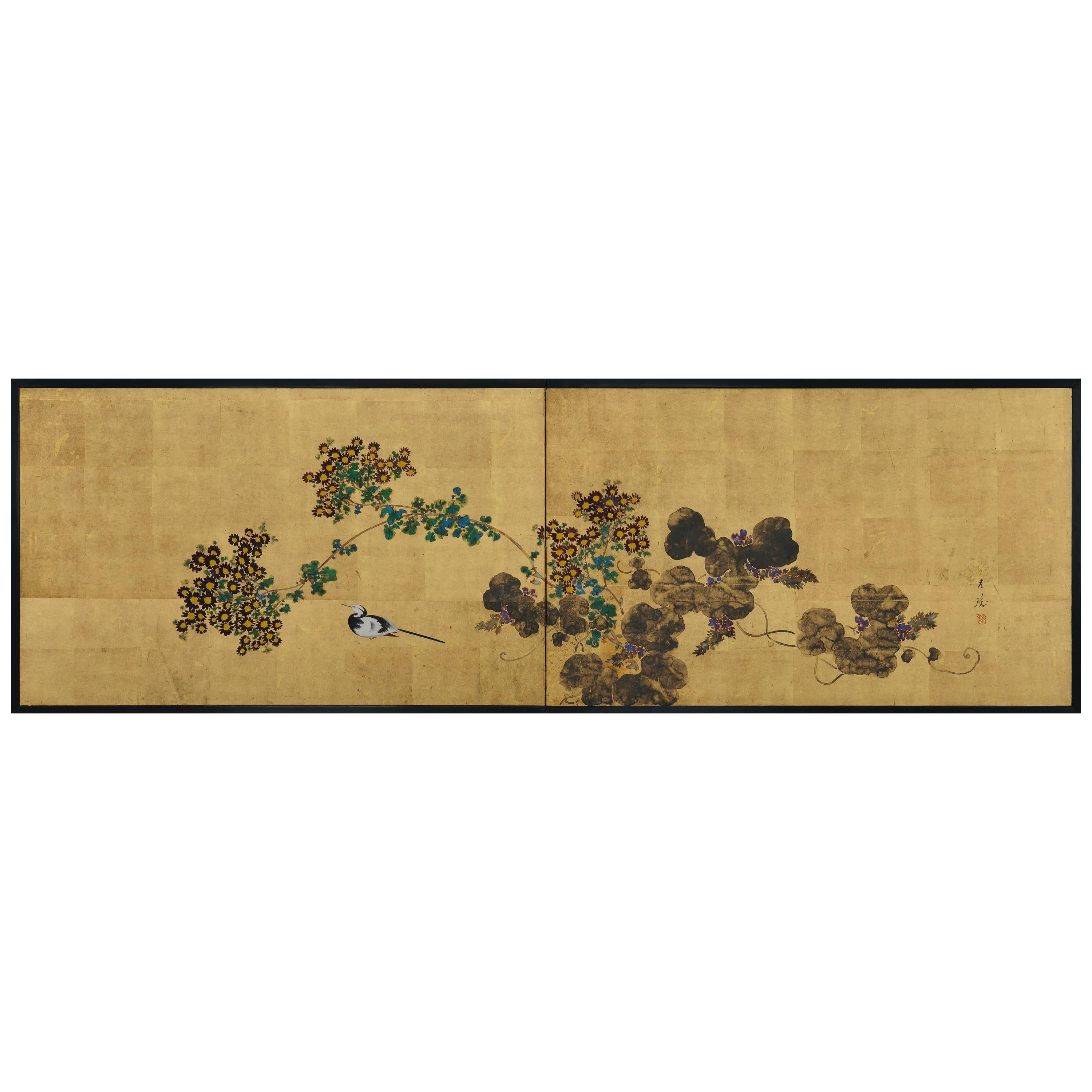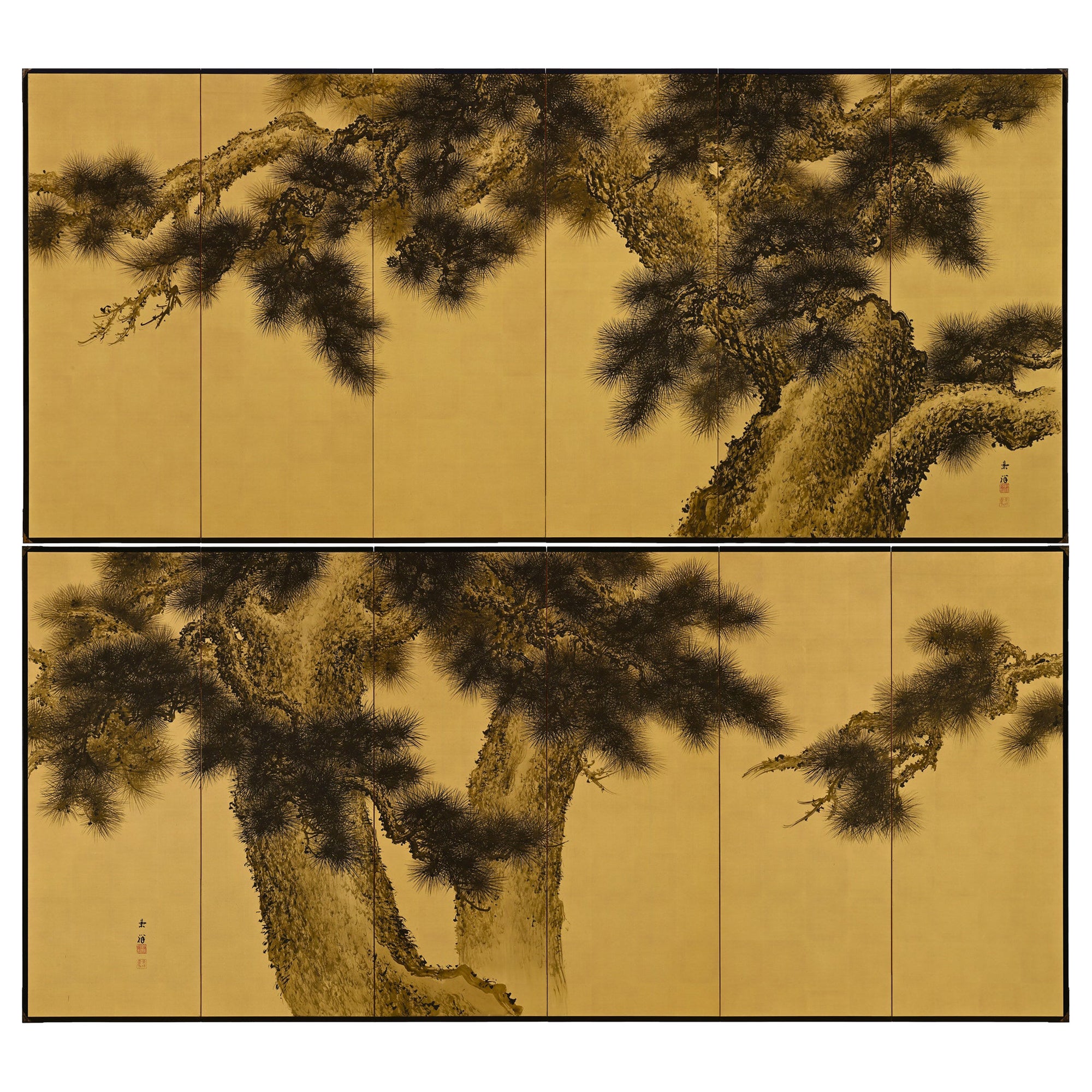Items Similar to Early 20th Century Japanese Screen Pair, Fig Trees by Hiroe Kashu 'B.1890'
Want more images or videos?
Request additional images or videos from the seller
1 of 15
Early 20th Century Japanese Screen Pair, Fig Trees by Hiroe Kashu 'B.1890'
About the Item
Fig Trees
Hiroe Kashu (b.1890)
Taisho era, circa 1920
Pair of six-fold Japanese screens
Ink, malachite, gold and silver on paper
Dimensions:
Each Screen measures H. 67’’ x W. 148” (170 cm x 376 cm)
In this major work we are presented with a complex composition of fig trees spanning across an expansive pair of six-panel Japanese screens. Laden with fruit, the scene is set in the depths of summer. The immersive scene creates a sense of being under the protective canopy of the enormous trees and elicits feelings of refreshment, respite and abundance. The broad, deeply lobed leaves are dappled with gold and speckled with droplets of silver, while diffused sunlight reflects off the smooth, white bark. The scene runs unbroken from right to left and abandoned prevailing compositional practices by treating all 12 panels as a continuous surface, paying no heed to the division between right and left hand screens.
The artist, Hiroe Kashu, has employed, on an almost unprecedented scale, the tarashikomi or “dripped in” mode of picture making. The leaves, fruit, trunks and branches are all detailed by the tarashikomi technique. The visual appeal of this method lies in the variegated and organic surface effects that result from the fusion of two different layers of paint, creating an effect of pooled colors with softly blurred edges. The interaction between the pigments is, at least to some degree, beyond the control of the painter, and the patterns that ensue add immeasurably to the visual interest of the painting. The successful tarashikomi effect also relies upon rapid application, as the second infusion of paint needs to be introduced before the initial layer dries. The enormous scale and complex layering of this work only magnifies the difficulty. The entire painting surface has been heavily sized before the application of ink and pigment. Sizing is used to reduce the paper's tendency to absorb liquid, with the goal of allowing inks and paints to remain on the surface of the paper and to dry there, rather than be absorbed into the paper. The tarashikomi technique is part of the Rinpa style of decorative arts and was initially pioneered in the early 17th century by Tawaraya Sotatsu. Most latter day Rinpa painters selectively applied the technique to local areas of a painting - in the case of this pair of fig tree screens it might be understood as less a technique than a total mode of picture making.
Hiroe Kashu was born in Kyoto in 1890. He graduated from the Kyoto University of the Arts in 1908 and then the Kyoto Municipal School of Painting in 1912. Whilst still a student, he was chosen to exhibit works at the Japan Art Academy’s national Bunten exhibitions. He first participated in 1911 and 1912 and received commendations on both works. He further exhibited in 1915, 1917, 1921, 1924 and 1927. After this he moved to Tokyo and became a portraiture artist.
The screens have recently been completely remounted in Kyoto utilizing traditional techniques and craftsmen.
- Dimensions:Height: 67 in (170.18 cm)Width: 148 in (375.92 cm)Depth: 0.75 in (1.91 cm)
- Style:Taisho (Of the Period)
- Materials and Techniques:
- Place of Origin:
- Period:
- Date of Manufacture:circa 1920
- Condition:Refinished. Wear consistent with age and use. The screens have recently been completely remounted in Kyoto utilizing traditional techniques and craftsmen.
- Seller Location:Kyoto, JP
- Reference Number:1stDibs: LU2472326077512
About the Seller
5.0
Recognized Seller
These prestigious sellers are industry leaders and represent the highest echelon for item quality and design.
Established in 2001
1stDibs seller since 2016
60 sales on 1stDibs
Typical response time: 6 hours
- ShippingRetrieving quote...Ships From: Kyoto, Japan
- Return PolicyA return for this item may be initiated within 10 days of delivery.
More From This SellerView All
- Early 20th Century Pair of Japanese Folding Screens, Deer Under Maple TreesLocated in Kyoto, JPDeer under maples Late Taisho period, circa 1925-1930 Pair of two-panel screens. Ink and pigment on silk. Signature: Goho Seal: Goho A pair of two-fold Japanese silk screens...Category
Vintage 1920s Japanese Taisho Paintings and Screens
MaterialsWood, Paper, Silk
- Japanese Screen, Early 20th Century Wagtail & Chrysanthemum by Ishizaki KoyoLocated in Kyoto, JPIshizaki Koyo (1884-1947) Wagtail & Chrysanthemum Early 20th century Folding screen in two-panels. Ink, pigments and gofun on gold leaf. Sign: Koyo Seal: Koyo This ...Category
Early 20th Century Japanese Taisho Paintings and Screens
MaterialsGold Leaf
- Early 20th Century Japanese Screen Pair - Ink Pine Trees on GoldLocated in Kyoto, JPImao Keisho (1902-1993) Pine Trees Early 20th Century, Circa 1930 Pair of six-panel Japanese screens. Ink on silk and gold leaf. Dimensions: Each screen H. 67.5” x 148” (172 cm x 376 cm) A pair of monumental six-panel Japanese pine screens by the renowned Nihonga artist Imao Keisho. Here Keisho entirely removed the background and brought the pine trees to the surface of the painting. This simplification of the elements makes the scene exceptionally direct and compelling and injects a very modern...Category
Early 20th Century Japanese Showa Paintings and Screens
MaterialsGold Leaf
- Early 20th Century Japanese Cherry Blossom Screen by Kano SanrakukiLocated in Kyoto, JPCherry Blossoms Kano Sanrakuki (1898-1981) Showa period, circa 1930 2-panel Japanese Screen Color, gofun and gold leaf on paper Against a backdrop of gold-leafed ground, the lichen covered trunk and branches of the life-sized cherry blossom tree reach out and beyond the confines of the pictorial surface. The overall composition has a feeling of flatness which draws emphasis to the surface and the three-dimensionality of the cherry blossoms. Painstakingly built-up layers of thickly applied shell-white gofun detail the voluminous blossoms and cover large areas of this tour-de-force of Japanese Nihonga painting. By simplifying the background, minimizing the number of colors and depicting the blossoms with such heavy relief, the artist has emphasized the stunning presence of the cherry tree. The type of tree depicted is the Yae-Zakura; a double-layered type of cherry blossom famed for its beauty and strength. When we think of Japanese cherry blossoms, the first thing that comes to mind is Somei Yoshino variety, which has a single flower with five almost white petals. This type is fragile and easily blown away by strong wind or rain. Most of the double-flowered cherry blossoms begin to bloom when the Somei-Yoshino falls, and the flowering period lasts longer than that of the Somei-Yoshino. Kano Sanrakuki originally studied painting at the Kyoto City Arts and Crafts School under the tutelage of Yamamoto Shunkyo...Category
Early 20th Century Japanese Showa Paintings and Screens
MaterialsGold Leaf
- Early 20th Century Japanese Framed Painting, White Peacocks on Silk and GoldLocated in Kyoto, JPKasahara Seiken White peacocks, circa 1916 Framed painting. Ink, color and gofun on silk. A Taisho period Japanese nihonga painting depicting a pair of white peacocks re...Category
Early 20th Century Japanese Taisho Paintings and Screens
MaterialsGold Leaf
- 17th Century Japanese Screen Pair by Soga Nichokuan, Hawks on Pine & Plum TreesLocated in Kyoto, JPHawks on plum and pine Soga Nichokuan (active circa 1625-1660) Pair of six-fold screens. Ink, mineral pigments, gofun, gold and speckled gold leaf on paper. Upper seal: H...Category
Antique 1640s Japanese Edo Paintings and Screens
MaterialsWood, Paper
You May Also Like
- Pair of Mid-20th Century chinoiserie Screens, Hand Painted,Located in Milano, ITPair of Mid-20th Century chinoiserie screens, hand painted, similar but different figures of Chinese notables.Category
Mid-20th Century French Chinoiserie Paintings and Screens
MaterialsFruitwood
- Early 19th Century Japanese Six-Panel Screen, Tropical GardenLocated in Hudson, NYWith a banana leaf palm on the left, at water's edge with geese. Perhaps a scene from the southern islands. Mineral pigments on mulberry paper with gold leaf and a silk brocade border.Category
Antique Early 19th Century Japanese Paintings and Screens
MaterialsGold Leaf
- Japanese Two Panel Screen: Pomegranate TreeLocated in Hudson, NYWith various flowers, manderin ducks and garden stone accented with gold leaf on ground surface. Nagasaki School Painting.Category
Antique Mid-19th Century Japanese Paintings and Screens
MaterialsSilver Leaf
- Pair of Burmese Early 20th Century Giltwood Framed PaintingsLocated in Lambertville, NJA pair of vibrantly colored Burmese water color paintings of Deities. The early 20th century paintings in mid 20th century professionally framed giltwood frames.Category
Early 20th Century Asian Paintings
MaterialsGlass, Giltwood, Paper
- Japanese Two Panel Screen Aviary Shaded by A Maple TreeLocated in Hudson, NYJapanese Two Panel Screen: Aviary Shaded By A Maple Tree, Showa period (1926 - 1989) painting of an outdoor bird enclosure under a maple tree. Painted in ...Category
Mid-20th Century Japanese Showa Paintings and Screens
MaterialsSilk, Wood, Paper
- Japanese Two Panel Screen: Gibbons in a TreeLocated in Hudson, NYInk painting on mulberry paper of gibbons in a tree with hints of gold in the sky.Category
Antique Early 18th Century Japanese Paintings and Screens
MaterialsPaper
Recently Viewed
View AllMore Ways To Browse
20th Century Screen
Traditional Asian Painting
W B Styles
20th Century Folding Screen
1911 Gold
Local Asian Furniture
Asia Picture
Japanese Screen Ink
Antique Decorative Screens
Decorative Screen Panel
Pair Silver Painting
Asian Painters
Paper Folding Screen
Papered Folding Screen
Pair Of Asian Art Paintings
Pair Of 20th Century Painted Panels
Pair Of Asian Paintings
1920 Trunks





